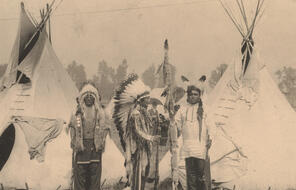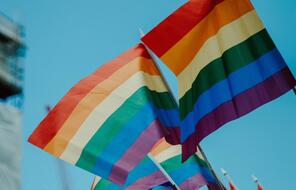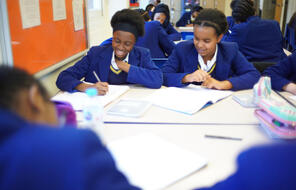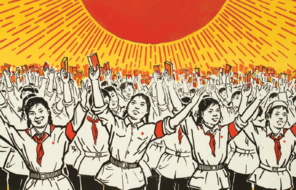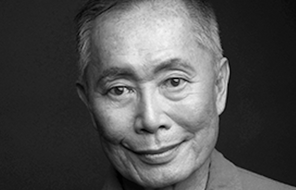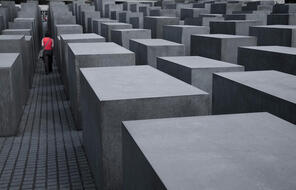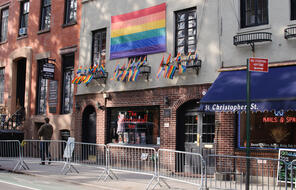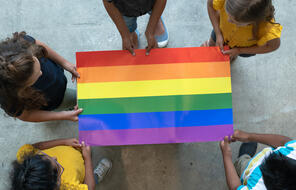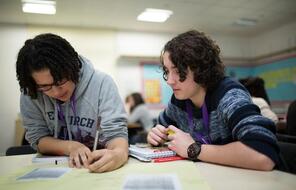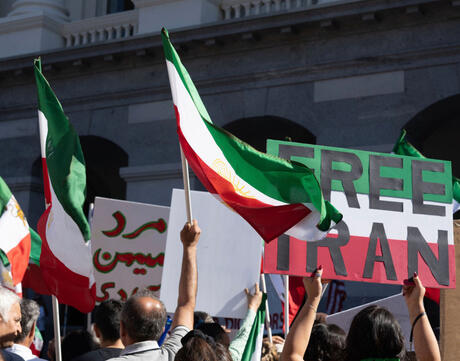
Between Two Worlds: An Iranian American’s Perspective on History, Identity, and Hope
A major component of almost any Facing History lesson is to reflect on one’s identity. The answer to “Who am I?” depends on a range of factors: how you define yourself, your membership in certain groups, and how other individuals and society label you. But connecting with one’s identity, including the people and places that shape an individual, can be much more complicated when your parents’ home country is too dangerous to visit. For our guest author “home” was always the United States, but the language, culture, and memories that colored her early life were all born in Iran. As she navigated her bi-cultural upbringing and identity as an Iranian American, she grappled with the question of where she belonged. This disconnect is a common feeling for many children of immigrants—to be both Iranian and American but to not fit neatly into either one of these definitions can be confusing and isolating.
For our guest author there is also the pain of knowing that her relatives, whom she has mostly known only from a distance, along with their fellow Iranians are in constant danger from the tyranny of the ruling regime. How does one square being safe while others are under threat?
We all know the world can be scary and uncertain, but that doesn’t mean we can close our eyes to the volatility. And there is always an opportunity to make a positive impact. Facing History strives to help young people understand that learning history—the ugly parts and the triumphant parts—allows us all to grow as a human species and connect with one another. As you and your students read this personal narrative, questions about what’s happening in Iran will certainly come up. Where Do We Get Our News and Why Does It Matter? can guide your class toward informative and trustworthy articles about the situation. And as you consider the turmoil in Iran, it can be a great moment to reflect on what can cause political instability or civil unrest. Democracy in the US only works when “we the people” make it a success. The Hope and Fragility of Democracy in the United States offers an examination of the tensions that we too face and why civic participation is a powerful tool.
Introduction: The Current State of Iran
*The author’s name is withheld to protect the identity of family members in Iran.
On September 16, 2022, a 22-year-old Kurdish Iranian woman fell into a coma in police custody and later died after being brutally beaten during her arrest by the Islamic Republic’s “morality police”—a special police force tasked with enforcing the government’s mandated dress code. Her name was Mahsa Jhina Amini, and her alleged crime was showing too much of her hair underneath her veil.
In a country whose government is known for its rampant abuses of power and barbaric crimes against its own citizens, the circumstances around Amini’s death were not uncommon, nor is the reality that likely no one will be held accountable for it. Her death, however, became the spark that ignited an entire country to rise up in protest against a dictatorial regime. And as those within the country rose, so too did an entire diaspora who dreamt of a free Iran.
Iranians are no strangers to civil unrest. In addition to the collective action that led to the Islamic Revolution of 1979 and brought to power Ayatollah Ruhollah Khomeini, widespread uprisings have occurred at least once a decade since the establishment of the Islamic Republic, including the Green Movement in 2009 and what became known as “Bloody November” in 2019. Each was met with a merciless, violent crackdown by the government’s forces, crushing dissent with impunity.
This time, however, it hasn't worked. Despite the government’s widespread, indiscriminate shooting of civilians with both live and blank ammunition intended to blind, mutilate, and kill; sweeping arrests on bogus charges for manufactured crimes (or those committed by the government itself); trials without due process; forced confessions under severe, prolonged physical and psychological torture; rushed executions; and the disruption of state-controlled internet in an effort to cut access to the world, protestors remain defiantly undeterred. As we mark one year since Amini’s murder, protests continue throughout Iran, some organized, and many through the most basic acts of resistance: couples holding hands in public; women showing their unveiled hair; singing and dancing in public—all considered crimes punishable by death under the Islamic Republic’s rule.
Though this revolution began with a woman and her allegedly improper hijab, it stands for so much more. The people of Iran are demanding an end to mandated dress codes; gender apartheid; mass executions; homophobia; unlawful imprisonment; crimes against humanity; ethnic cleansing of the country’s many minorities, including Kurdish and Balochi; persecution of and discrimination against citizens of Baha’i, Jewish, and other non-Islamic faiths; and at the core of it all, an end to the theocratic dictatorship that has destroyed the country’s economy, environment, and diplomatic standing within the international community. These demands have been captured in the simple yet powerful chant heard around the world: Woman. Life. Freedom.
Over the past year, I’ve watched from a distance as this uprising—the next revolution—plays out in Iran. With it comes the worry, the sorrow, the guilt, the pride, and the full spectrum of complicated, intense emotions that have consumed me and every Iranian I know. Each update is more gut wrenching than the last. Each time there’s a glimmer of hope, the next video brings shock and horror which turns to anger and determination. I want to share why the upheaval in Iran matters so much to me on a personal level rather than offer generalizations about policies and government practices that some may find harder to relate to. In doing so, I hope it provides insight into the widespread effects of what has happened to many of us over the past four decades under the rule of the Islamic Republic.
My Family’s Story
My parents were practically kids (18 and 23) when they left Iran around 1977, originally intending to study abroad and eventually return home. By the time they completed their degrees, the Iran they knew no longer existed.
They were among the lucky ones to have left when they did, just before the rise of the Islamic Republic. ”Lucky,” as if leaving your home in time to avoid persecution is a matter to be celebrated. “Lucky” to have left their families behind.
Though they never spoke much of their early years in America, over time I’ve pieced together some of what their experience was like (note: it wasn’t easy), but I will probably never know the extent of the trauma they experienced from leaving Iran and coming to the United States during such a hostile time. It wasn’t much of a choice—go home and suffer, or stay away and be free. They persevered and sacrificed for their freedom and for the freedom of their future children.
It’s because of the sacrifices my parents made that I am who I am, that I get to be this person today. The immense guilt I feel for my freedom has been a prominent fixture in my mind these last twelve months. Why should I get to dress how I want, love who I want, be who I want while my compatriots in Iran are killed for wanting the very same basic freedoms? Why me and not them?
Had only a few factors been slightly different, I might’ve been a victim of the morality police, killed for the crime of showing a strand of hair. It might’ve been me protesting in the streets chanting “Death to the dictator!” screaming, bleeding, and dying for the cause of freedom. Would my older brother have survived his mandatory military service? Would our beliefs and values be any different? Would we be obedient, or would we be among those imprisoned for speaking out? What would life even look like for us under the barbaric oppression of the Islamic Republic, knowing a whole world—a freer world—existed outside the borders of our country? These what-ifs run through my mind constantly as I process the cruelty I witness being inflicted upon the people of Iran.
Although my parents made a point to keep the connection to our heritage alive in our home by teaching us the Persian language, decorating our home with Persian art and rugs, cooking elaborate Persian meals every single day, and practicing many of the same customs from the homeland, assimilation is a tricky balancing act. And it is very much an act as far as I’m concerned.
On the one hand, we wanted deeply to “fit in” and be accepted as members of our community. This meant adopting traditions that generally meant nothing to us, such as celebrating Christmas and Thanksgiving (why are sweet potatoes and marshmallows a dish in this country?). We avoided speaking our language above a whisper in public for fear of harassment. Some of us went by less “ethnic” nicknames or middle names to avoid our Persian names raising questions. Any attention was concerning—we didn’t want to stand out, so in public, we often made ourselves small to blend in.
On the other hand, our customs, culture, and home were undeniably different from our neighbors. As a child, I might’ve felt embarrassed about the latter, but as an adult, I’m beyond grateful that I was raised through and through Iranian first, American second. I am the child of immigrants and I couldn’t be prouder of it. But watching the events unfold in Iran since September 2022 has awoken a part of me that I’d kept buried so deep inside my heart, I’ve never fully acknowledged it.
Yes, my parents were among the lucky ones. But what they gave up for us to be here and not there has left me with a longing and heartache so intensely powerful, I’m struggling to breathe under the weight of it. That part of me is open now, and I’m overrun with decades worth of pain.
My parents created a community, a family, here in America because they had to leave their own. I had countless “amoos” (uncles) and “khalehs” (aunts) who were actually friends and not blood relatives. Their children were my “cousins.” I recall asking many of the older women in our circle if they’d be my grandmother because I couldn’t be with mine.
But our actual relatives, our aunts and uncles, our grandparents and cousins, were mostly on the other side of the world, scattered like puzzle pieces: some in Europe, some in Canada, and some still in Iran. All were separated in large part because of a government that took their country from them. There were very occasional visits among those of us outside of Iran, but the distance made it difficult to develop stronger ties, particularly since this was well before social media and internet access we’re accustomed to today.
As for those still in Iran, watching the uprising there has provided a poignant reminder of what this regime has cost my family. It’s been 18 years since I last visited Iran. Eighteen years since I last hugged my aunt. In my 34 years, I’ve been with my Iranian cousins just twice. This regime has kept generations of families apart and the widespread implications of this are immeasurable.
For 44 years we’ve carried on without one another. We’ve grown up not really knowing one another. We’ve missed birthdays and anniversaries, weddings, and funerals. We’ve celebrated apart. We’ve mourned alone, isolated from the people we needed most. My older brother hasn’t been back to Iran in decades because, as a dual citizen, he would be required to serve in the military. My 13-year-old little brother hasn’t even met half of his family. Our grandparents died before he could ever visit them. We’ve never been to their graves.
I now wonder, who might I have become if I’d had access to and connection with these people who are practically strangers to me? How might all our lives be different if we hadn’t been kept apart?
All these missing pieces from the puzzle that is my identity have left me with a profound sense of loss and emptiness, almost as though I’m grieving for what could have been. For all that we didn’t get to experience together, for all that they took from us, for all the opportunities to know and truly appreciate my heritage, I mourn. I stand with the people of Iran – for woman, life, and freedom.
Resources for the Classroom
Unit: My Part of the Story: Exploring Identity in the United States
Help students understand that their voices are integral to the story of the United States with six lesson plans that investigate individual and national identity.
Mini-Lesson: Why Do People Migrate?
Ask students to reflect on stories of migration as they learn about multiple migration journeys faced by people from different countries. Explore the underlying factors that drive migration.
Explainer: What is Migration?
Use this resource to help differentiate between terms like refugee, migrant, and asylum.
Reading: “Outlawing the Opposition”
Learn about Hitler’s early measures against "enemies of the state.” Laws such as the Malicious Practices Act made even the smallest expression of dissent a crime.
Lesson Plan: Why Iranians Are Protesting
The death of a young woman has prompted an outpouring of anger across Iran. In this lesson from The New York Times students will learn about the many factors that have led to this moment.

